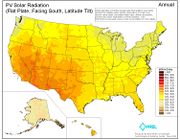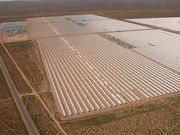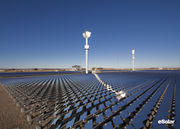Solar power plants in the Mojave Desert
There are several solar power plants in the Mojave Desert which supply power to the electricity grid. Solar Energy Generating Systems (SEGS) is the name given to nine solar power plants in the Mojave Desert which were built in the 1980s. These plants have a combined capacity of 354 megawatts (MW) making them the largest solar power installation in the world.[1] Nevada Solar One is a new solar thermal plant with a 64 MW generating capacity, located near Boulder City, Nevada.[2] There are also plans to build other large solar plants in the Mojave Desert. The Ivanpah Solar Power Facility is a proposed 392 MW facility which will consist of three separate solar thermal power plants.[3]
Insolation (solar radiation) in the Mojave Desert is among the best available in the United States, and some significant population centers are located in the area. This makes the Mojave Desert particularly suitable for solar power plants. These plants can generally be built in a few years because solar plants are built almost entirely with modular, readily available materials.[4]
Contents |
Overview

The southwestern United States is one of the world's best areas for insolation, and the Mojave Desert receives up to twice the sunlight received in other regions of the country. This abundance of solar energy makes solar power plants an attractive alternative to traditional power plants, which burn polluting fossil fuels such as oil and coal.[5] Unlike traditional power plants, solar power stations provide an environmentally benign source of energy, produce virtually no emissions, and consume no fuel other than sunlight.[5]
Currently, solar electricity is not cost competitive with bulk, baseload power — but it does not have to be. Instead, it provides electricity when and where power is most limited and most expensive, which is a highly valuable and strategic contribution. Solar electricity mitigates the risk of fuel-price volatility and improves grid reliability.[6]
While many of the costs of fossil fuels are well known, others (pollution related health problems, environmental degradation, the impact on national security from relying on foreign energy sources) are indirect and difficult to calculate. These are traditionally external to the pricing system, and are thus often referred to as externalities. A corrective pricing mechanism, such as a carbon tax, could lead to renewable energy, such as solar thermal power, becoming cheaper to the consumer than fossil fuel based energy.[4]
Solar thermal power plants can generally be built in a few years because solar plants are built almost entirely with modular, readily available materials. In contrast, many types of conventional power projects, especially coal and nuclear plants, require long lead times.[4]
Plants
Solar One and Solar Two

Solar power towers use thousands of individual sun-tracking mirrors (called heliostats) to reflect solar energy onto a central receiver located on top of a tall tower. The receiver collects the sun's heat in a heat-transfer fluid that flows through the receiver. The U.S. Department of Energy, and a consortium of U.S. utilities and industry, built the first two large-scale, demonstration solar power towers in the desert near Barstow, California.[5]
Solar One operated successfully from 1982 to 1988, proving that power towers work efficiently to produce utility-scale power from sunlight. The Solar One plant used water/steam as the heat-transfer fluid in the receiver; this presented several problems in terms of storage and continuous turbine operation. To address these problems, Solar One was upgraded to Solar Two, which operated from 1996 to 1999. Both systems had the capacity to produce 10 MW of power.[5]
The unique feature of Solar Two was its use of molten salt to capture and store the sun's heat. The very hot salt was stored and used when needed to produce steam to drive a turbine/generator that produces electricity. The system operated smoothly through intermittent clouds and continued generating electricity long into the night.[7]
Solar Two was decommissioned in 1999, and was converted by the University of California, Davis, into an Air Cherenkov Telescope in 2001, measuring gamma rays hitting the atmosphere.
Solar Energy Generating Systems

Trough systems predominate among today's commercial solar power plants. Nine separate trough power plants, called Solar Energy Generating Systems (SEGS), were built in the 1980s in the Mojave Desert near Barstow by the Israeli company Luz Industries. These plants have a combined capacity of 354 MW. Today they generate enough electricity to meet the power needs of approximately 500,000 people.[1]

Trough systems convert the heat from the sun into electricity. Because of their parabolic shape, trough collectors can focus the sun at 30-60 times its normal intensity on a receiver pipe located along the focal line of the trough. Synthetic oil circulates through the pipe and captures this heat, reaching temperatures of 390 °C (735 °F). The hot oil is pumped to a generating station and routed through a heat exchanger to produce steam. Finally, electricity is produced in a conventional steam turbine.[1] The SEGS plants are configured as hybrids to operate on natural gas on cloudy days or after dark, and natural gas provides 25% of the total output.[1]
Nevada Solar One
Nevada Solar One has a 64-MW generating capacity and is located in Boulder City, Nevada. It was built by the U.S. Department of Energy, National Renewable Energy Laboratory, and Acciona Solar.[2]
Nevada Solar One uses parabolic troughs as thermal solar concentrators, heating tubes of liquid which act as solar receivers. These solar receivers are specially coated tubes made of glass and steel, and about 19,300 of these four meter long tubes are used in the newly built power plant. Nevada Solar One also uses a technology that collects extra heat by putting it into phase-changing molten salts. This energy can then be drawn at night.[2]
Solar thermal power plants designed for solar-only generation are well matched to summer noon peak loads in prosperous areas with significant cooling demands, such as the south-western United States. Using thermal energy storage systems, solar thermal operating periods can even be extended to meet baseload needs.[8]
The cost of Nevada Solar One is in the range of $220–250 million. The power produced is slightly more expensive than wind power, but less than photovoltaic (PV) power.[9]
Nellis Solar Power Plant

In December 2007, the U.S. Air Force announced the completion of the Nellis Solar Power Plant, a solar photovoltaic (PV) system, at Nellis Air Force Base in Clark County, Nevada. Occupying 140 acres (57 ha) of land leased from the Air Force at the western edge of the base, this ground-mounted photovoltaic system employs an advanced sun tracking system, designed and deployed by PowerLight subsidiary of SunPower. Tilted toward the south, each set of solar panels rotates around a central bar to track the sun from east to west.[10] The 14-megawatt (MW, million watt) system will generate more than 30 million kilowatt-hours of electricity each year (about 82 thousand kilowatt-hours per day) and supply approximately 25 percent of the total power used at the base. The Nellis Solar Power Plant is one of the largest solar photovoltaic systems in North America.[11][12]
Sierra SunTower

The Sierra SunTower is a 5 MW commercial concentrating solar power (CSP) plant built and operated by eSolar. The plant is located in Lancaster, California and is the only CSP tower facility operating in North America. The project site occupies approximately 8 hectares (20 acres) in an arid valley in the western corner of the Mojave Desert at 35° north latitude.
Ivanpah Solar Power Facility
The 370 MW Ivanpah Solar Power Facility, located 40 miles southwest of Las Vegas, is the world’s largest solar-thermal power plant project currently under construction.[13] BrightSource Energy received a $1.37 billion loan guarantee from the United States Department of Energy to build the project, which will deploy 347,000 heliostat mirrors focusing solar energy on boilers located on centralized solar power towers.[13]
Mojave Solar Park
Solel has signed a contract with Pacific Gas and Electric (PG&E) to build the world's largest solar plant in the Mojave Desert. When fully operational in 2011, the proposed Mojave Solar Park will have an installed capacity of 553 megawatts of solar power, calculated to power 400,000 homes, to PG&E’s customers in northern and central California. The plant will cover up to 6,000 acres (2,400 ha) of land.[14][15]
Note difference between installed capacity and power output. A 500 MW installation working at full capacity for one hour will produce 500,000,000 watt-hours or 500,000 kilowatt-hours, kWh. Optimal hours are three hours on each side of solar noon. A full working day is about 14 hours at latitude 35 N.
AV Solar Ranch One
AV Solar Ranch One () is a proposed 230 MW power station owned by NextLight Renewable Power. The photovoltaic array will occupy about 2,100 acres (850 ha) in the Antelope Valley. If the project begins construction in 2010, it is expected to be fully operational by 2013, producing about 600 gigawatt-hours (GW·h) of energy annually — enough to meet the needs of 70,000 homes. The cost of the project has not been disclosed, but in June 2009, Pacific Gas & Electric (PG&E) announced an agreement with NextLight to buy the power produced by the project for 25 years for not more than 13.3 ¢/kW·h.[16][17][18]
Land use issues
Solar thermal power plants are large, but when looking at electricity output versus total size, they use less land than hydroelectric dams (including the size of the lake behind the dam) or coal plants (including the amount of land required for mining and excavation of the coal). While all power plants require land and have an environmental impact, the best locations for solar power plants are deserts or other land for which there might be few other human uses.[4]
Some of the land in the eastern portion of the Mojave Desert is to be preserved, but the solar industry is more interested in areas of the western desert, "where the sun burns hotter and there is easier access to transmission lines".[19]
See also
- Deployment of solar power to energy grids
- List of solar thermal power stations
- Renewable energy commercialization
References
- ↑ 1.0 1.1 1.2 1.3 SunLab (1998).Solar Trough Systems Retrieved December 18, 2008.
- ↑ 2.0 2.1 2.2 Utility-Scale Solar Plant Goes Online in Nevada Environment News Service, June 4, 2007. Retrieved December 18, 2008.
- ↑ Steven Mufson. Solar power project in Mojave Desert gets $1.4 billion boost from stimulus funds Washington Post, February 23, 2010.
- ↑ 4.0 4.1 4.2 4.3 Solel (2007).Ten facts about solar thermal power Retrieved December 18, 2008.
- ↑ 5.0 5.1 5.2 5.3 National Renewable Energy Laboratory (2001). Concentrating Solar Power: Energy from Mirrors Retrieved December 18, 2008.
- ↑ Photovoltaic Systems Research & Development. PV Roadmap Retrieved December 24, 2008.
- ↑ Sandia Labs Shares Major Solar Success With Industrial Consortium Sandia News Release, June 5, 1996. Retrieved December 18, 2008.
- ↑ Spain Pioneers Grid-Connected Solar-Tower Thermal Power p. 3. Retrieved December 19, 2008.
- ↑ A New Chapter Begins for Concentrated Solar Power Renewable Energy Access, February 11, 2006. Retrieved December 18, 2008.
- ↑ SunPower (2007). Nation’s Largest Solar PV System Takes Flight at Nellis Air Force Base Retrieved December 18, 2008.
- ↑ PV System Completed at Nellis Air Force Base Renewable Energy Access, December 18, 2007. Retrieved December 18, 2008.
- ↑ Largest U.S. Solar Photovoltaic System Begins Construction at Nellis Air Force Base PRNewswire, April 23, 2007. Retrieved December 18, 2008.
- ↑ 13.0 13.1 Todd Woody. In California’s Mojave Desert, Solar-Thermal Projects Take Off Yale Environment 360, 27 October 2010.
- ↑ Israeli company to build largest solar park in world in US Ynetnews, July 26, 2007. Retrieved December 18, 2008.
- ↑ Looking to the sun, Tom Parry, Canadian Broadcasting Corporation, August 15, 2007.
- ↑ "AV Solar Ranch One". NextLight Renewable Power LLC. 2009. http://www.avsolarranchone.com/default.asp. Retrieved 2009-06-06.
- ↑ "PG&E Purchases More Solar Power to Serve California Customers". PRNewswire. June 5, 2009. http://www.istockanalyst.com/article/viewiStockNews/articleid/3259335. Retrieved 2009-06-06.
- ↑ Sweet, Cassandra (June 5, 2009). "CORRECT: NextLight, Not EIX Unit Owns Land For Solar Farm". The Wall Street Journal. http://online.wsj.com/article/BT-CO-20090605-709305.html. Retrieved 2009-06-06.
- ↑ A Mojave power failure A shortfall in Mojave protection bill, Los Angeles Times, editorial, December 26, 2009.
External links
- Huge Solar Plants Bloom in Desert
- Solar plant planned in California desert
- Economic, Energy, and Environmental Benefits of Concentrating Solar Power in California
- Nevada No. 2 in solar power development
|
||||||||||||||||||||